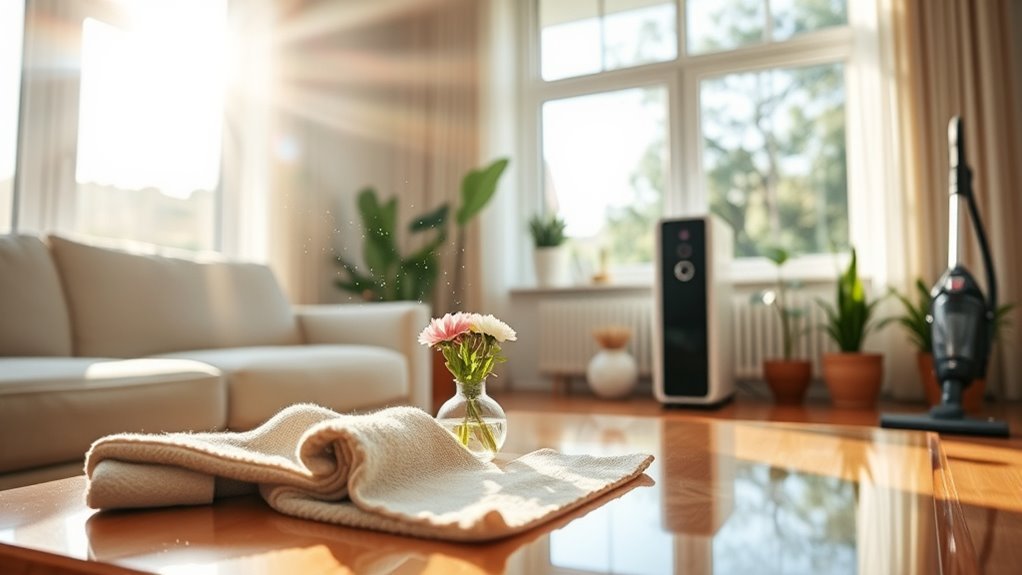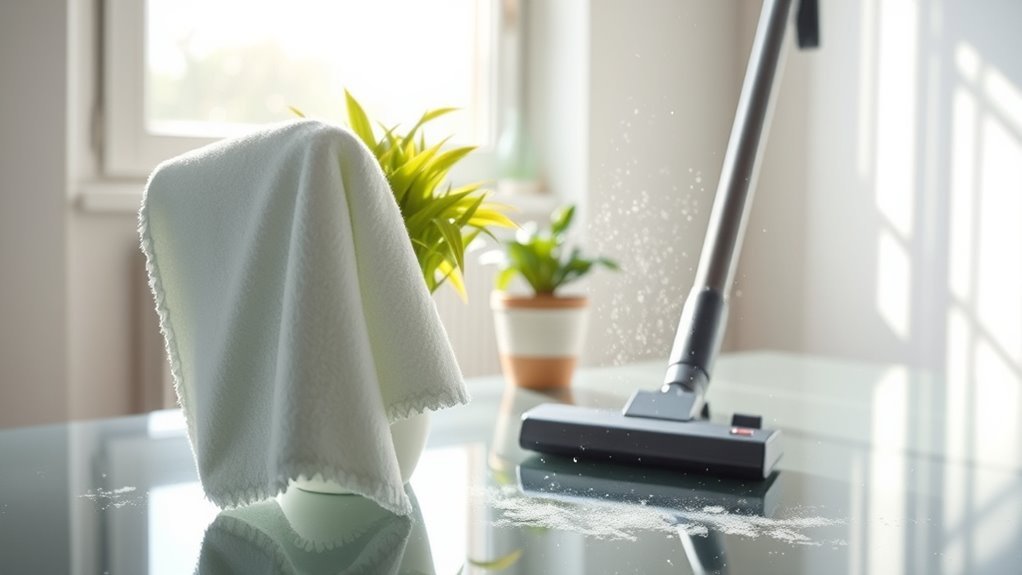How to Clean Your Dust in 10 Minutes
To clean your dust in 10 minutes, start by gathering a microfiber cloth or lightweight duster and a small vacuum or brush. Begin dusting from high surfaces like shelves and ceiling fans, working downward to avoid resettling dust. Use damp cloths for wood and dry cloths for electronics. Don’t forget corners, behind appliances, and top shelves. Finish by running an air purifier to trap airborne dust. Following a quick routine like this helps maintain a cleaner home—there’s more to learn about fine-tuning these steps.
Gather Your Dust-Cleaning Supplies

Before you begin dusting, gather all the essential supplies you’ll need. Start with quality cleaning tools—choose a lightweight duster or microfiber dusting cloths that trap dust efficiently. Avoid feather dusters, as they tend to spread dust rather than remove it. Have a small vacuum or handheld brush handy for tougher spots. Prepare a spray bottle with water or a mild cleaning solution to slightly dampen your dusting cloths; this helps capture dust without scattering it. Keep a step stool nearby if you need to reach higher areas. Organizing these supplies before you start guarantees you move swiftly and efficiently through the task. With the right cleaning tools and dusting cloths, you gain control over your environment, freeing up time to enjoy what matters most.
Start With High Surfaces and Work Downward
Since dust naturally settles downward, you’ll want to start with high surfaces like shelves, ceiling fans, and light fixtures. This method prevents re-dusting lower areas you’ve already cleaned. Use appropriate cleaning tools: microfiber cloths for shelves, extendable dusters for fans, and soft brushes for light fixtures. Employ dusting techniques that trap dust instead of spreading it.
| Surface Type | Recommended Cleaning Tool |
|---|---|
| Ceiling Fans | Extendable Duster |
| High Shelves | Microfiber Cloth |
| Light Fixtures | Soft Brush |
| Picture Frames | Electrostatic Duster |
Use the Right Techniques for Different Materials

After tackling dust on high surfaces, focus shifts to adapting your cleaning methods based on the material you’re handling. Different surfaces demand different care to keep them dust-free without damage.
Adjust your cleaning strategy to suit each surface, ensuring dust removal without causing harm.
- For wood surfaces, use a soft, slightly damp microfiber cloth to lift dust gently without scratching or stripping finishes.
- When cleaning electronic devices, avoid liquids; use a dry microfiber cloth or compressed air to clear dust from keyboards, screens, and vents carefully.
- For delicate fabrics or upholstery, opt for a vacuum with a brush attachment or a lint roller to remove dust without harming the material.
Don’t Forget Hard-to-Reach Areas
Even if you’ve dusted every visible surface, dust can still accumulate in hard-to-reach areas. Don’t skip corners cleaning or ceiling fans, as these spots trap dust and diminish the fresh feeling you want in your space. Use a microfiber cloth on an extendable duster to access these areas quickly and efficiently.
| Area | Why It Matters |
|---|---|
| Corners | Dust builds up unnoticed |
| Ceiling Fans | Spin dust back into air |
| Behind Appliances | Hidden dust nests grow |
| Top Shelves | Often overlooked spots |
Focusing on these areas frees you from recurring dust buildup, making your environment cleaner and healthier with minimal effort.
Finish With Air Purification and Maintenance Tips

One key step to complete your dust-cleaning routine is to use air purification and establish regular maintenance habits. Choosing the right air purifier selection is vital; pick one with a HEPA filter for maximum dust capture. After cleaning, run your air purifier to trap airborne particles, improving air quality and reducing future dust buildup. Don’t skip routine maintenance to keep your space dust-free longer.
- Replace or clean air purifier filters as recommended.
- Schedule weekly quick dusting to prevent accumulation.
- Keep windows and vents clean to minimize dust entry.
Frequently Asked Questions
How Often Should I Deep Clean My Dusters?
You should deep clean your dusters every 1 to 2 months to maintain effective dust maintenance. If you dust frequently or have pets, consider doing it monthly to prevent buildup. Regular deep cleaning guarantees your dusters pick up debris efficiently, saving you time and effort. Just rinse them with warm water and mild detergent, then air dry completely. Keeping up with this routine helps you enjoy a cleaner, freer living space without hassle.
Can Dusting Reduce Allergy Symptoms Effectively?
Think of dust as tiny invaders hiding in your home, stirring up allergy triggers like dust mites. Dusting regularly sweeps these unwelcome guests away, reducing your exposure and easing allergy symptoms effectively. By staying methodical and consistent, you’ll keep your space freer and healthier. Focus on high-touch areas and fabrics where dust mites love to nest. This practical habit empowers you to breathe easier and enjoy your home without constant allergy discomfort.
What Are the Best Eco-Friendly Dusting Products?
You’ll want to choose plant-based cleaners that are tough on dust but gentle on the environment. They’re biodegradable and free from harsh chemicals, making your space healthier. Pair these with microfiber cloths—they trap dust effectively without needing sprays, reducing waste. This combo lets you clean efficiently and responsibly, giving you the freedom to maintain a fresh home without compromising the planet’s well-being. It’s practical, eco-friendly, and easy to stick with.
Is It Better to Dust Before or After Vacuuming?
You should dust before vacuuming to get the best results. Dusting techniques work by loosening particles from surfaces, which then settle on the floor. If you vacuum first, you’ll miss out on capturing that debris. Following the right vacuuming order—dust first, vacuum second—ensures your space is truly clean without extra effort. This method saves time and gives you the freedom to enjoy a dust-free environment with less hassle.
How to Prevent Dust From Accumulating Quickly?
Dust is like an uninvited guest that sneaks in when you’re not looking. To keep it at bay, take preventive measures: seal windows and doors, use air purifiers, and opt for easy-to-clean surfaces. Regular maintenance is key—schedule weekly dusting and vacuuming to stop buildup before it starts. By staying methodical and practical, you’ll enjoy a freer, cleaner space without the constant battle against dust settling in.






